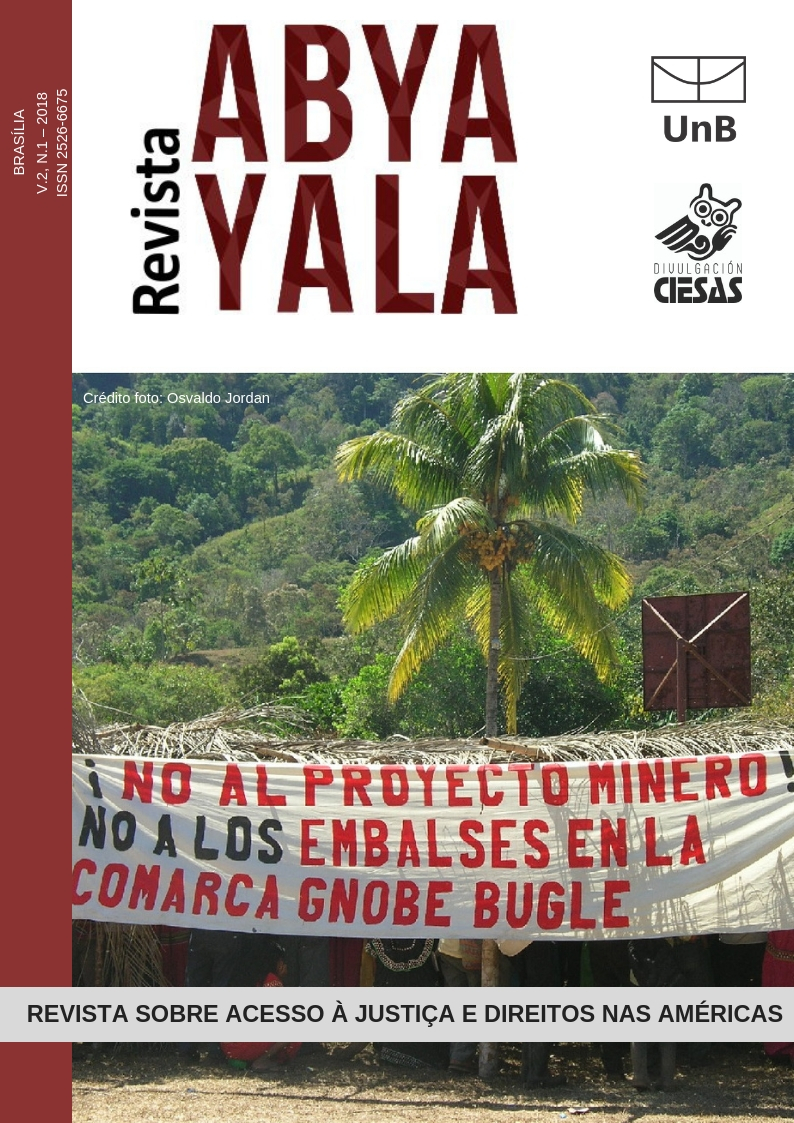Internecine entre el Estado indio y los adivasis (indígenas), bajo el neoliberalismo
El caso del movimiento de resistencia Lanjigarh
DOI:
https://doi.org/10.26512/abyayala.v2i1.10695Palabras clave:
Movilización colectiva, movimientos de protesta tribal, nuevos movimientos sociales, sociedad civil, neoliberalismoResumen
El movimiento anti Vedanta en Lanjigarh sacudió el distrito de Kalahandi, en el interior del estado indio de Odisha. El fue un movimiento ferozmente combatido (2002-2014) por los Adivsis (Dongria Kondh) contra el estado de Odisha y VAL, el metal pesado basado en la minería MNC, licenciado bajo la política neoliberal. El proyecto había desalojado a 302 familias adivasis y minó las montañas de Niyamgiri, a las que los Adivasis estaban vinculados a su sustento y propósitos religioso-culturales. Los desplazados se movilizaron en torno a cuestiones de amenazas culturales, ambientales y medidas inadecuadas de R & R contra la pérdida de medios de subsistencia y el hábitat natural. El artículo analiza empíricamente: (i) las amenazas impuestas a la identidad Adivasi por este proceso de modernización, poniendo en riesgo sus patrones culturales, relaciones sociales, organizaciones económicas y ecosistema primitivo; (ii) las paradojas inherentes a ese discurso de desarrollo basado en el neoliberalismo, la medida en que el estado impone un determinado modelo de desarrollo (superando el derecho de los sujetos a experimentar el desarrollo de forma diferente); (iii) como la sociedad civil orientó el movimiento para asegurar la implementación de disposiciones legales relevantes, tales como el quinto cronograma de la constitución, el artículo 244, PESA 1996, FRA 2006 y los Odisha scheduled areas act (1956), para proteger los adivasis. Concluye que el estado está siendo forzado a dividir espacio con la sociedad civil como resultado del neoliberalismo..
Descargas
Citas
AMNESTY INTERNATIONAL , Executive Summary of Report: Don’t Mine Us out of Existence: Bauxite Mine and Refinery Devastate Lives in India, Index: ASA 20/004/2010, Tuesday 9 February, 2010. International Secretariat, Amnesty International, 1 Easton St., London WC1X 0DW, UK. https://www.amnesty.org/download/Documents/36000/asa200042010en.pdf
BABOO, Balgovind, “State Policies and People's Response: Lessons from Hirakud Dam”, Economic and Political Weekly, Vol. 26, No. 41 (Oct.12), pp. 2373-75 and 2377-79. 1991.
BANERJEE, Parthasarathi “West Bengal: Land Acquisition and Peasant Resistance at Singur”, Economic and Political Weekly, 41(16), pp. 4718”“20. 2006.
BAVISKAR, Amita, “In the Belly of the River, Tribal Conflict over Development in the Narmada Valley”, Delhi, Oxford University Press, 1995. 286p.
http://www.cseindia.org/node/1680
COHEN, Jean. “Strategy or Identity: New Theoretical Paradigm and Contemporary Social Movements”, Social Research, Vol 52, No 4; pp. 663-716. 1985.
CROOK, Stephen, Jan Pakulski and Malcolm Waters, Postmodernization: Change in Advanced Society, Delhi, Sage. 1994.
D’MONTE, Darryl, “Green at the Grassroots”, Seminar, Vol 355, March, pp.16-20. 1989.
DWIVEDI, Ranjit, “Displacement, Risks and Resistance: Local perceptions and Actions in the Sardar Sarovar”, Development and Change, Vol. 30. pp. 43-78. 1999.
-------------, Conflict and Collective Action: The Sardar Sarovar Project in India, Routledge. 2006. 402p.
EDWARDS, Michael and Hulme David, “Scaling-up the Development Impacts of NGOs: Concepts and Experiences”, in Michael E and David H (ed) Making a Difference: NGOs and Development in a Changing World, London, Earth Scan, 1992. pp.13-27.
FRANK, Andre Gunder, and Fuentes Marta, “Nine Theses on Social Movement”, Economic and Political Weekly Vol. XXII, No.35, Aug 29, pp. 1503-1510. 1987.
FUENTES, Marta and Frank, Andre Gunder, “Ten theses on Social Movement”, World Development, Vol. XVII (2), pp.79-91. 1989.
http://www.indianexpress.com/news/environment-body-cancels-goahead-to-vedanta/683338/
http://www.mydigitalfc.com/economy/centre-issues-2-showcause-notices-vedanta-521
http://news.bbc.co.uk/2/hi/8500997.stm
OLIVER-SMITH, Anthony, Displacement, Resistance and the Critique of Development: From the Grassroots to the Global, Final report prepared for ESCOR R7644 and Research Programme on Development Induced Displacement and Resettlement, Refugee Studies Centre, University of Oxford. 2001.
OOMMEN, Tharaileth Koshy, “Multiple Modernities and the Rise of New Social Movements: The case of India”, Indian Social Science Review, Vol.3, No.1, Jan, pp 1-16. 2001.
PADEL, Felix and Samarendra Das, “Orissa’s Highland Clearances: the Reality gap in R& R”, Social Change, Vol 38, No 4, pp, 576-608, 2008.
PATEL, Sujata et al, Bheeta Maati- Our Soil, Our Earth, Our Home: A report on Missile Base and struggle, Delhi, PUDR, August, Record No. CL 010015, 1988.
PATEL, Sujata, “Agni, Cyclone and Baliapal Agitation”, Economic and Political Weekly, Vol. 24, No. 25, 24 Jun. pp. 1381-1382. 1989.
PEOPLE’S TRIBUNAL, “Nandigram: What Really Happened?” (Report on Nandigram), All India Citizens Initiative, Delhi, Daanish Books, 2008. 102p.
ROUTLEDGE, Paul, Terrains of Resistance: Nonviolent Social movements and contestations of place in India, West Port, Praeger Publishers, Ch-3, pp39-74. 1993.
SAMAL, Kishor, “Shrimp Culture in Chilika Lake: Case of Occupational Displacement of Fishermen”, Economic and Political Weekly, Vol. 37, No. 18 (May 4-10), pp. 1714-1718. 2002
SARKAR, Abhirup, 2007, “Development and Displacement”. Economic and Political Weekly, Vol 42, No. 16, pp16-21, 2006.
THE TIMES OF INDIA (TOI), “ONGC Won’t Counter Vedanta’s $10.bn offer”, Kanpur edition, d. 25.9.2010, p.13.
TOURAINE, Alain. “An Introduction to the Study of Social Movements”, Social Research, Vol.52, No 4, pp.749-788. 1985.
Descargas
Publicado
Cómo citar
Número
Sección
Licencia
Derechos de autor 2018 Abya-Yala: Revista sobre Acceso a la justicia y derechos en las Américas

Esta obra está bajo una licencia internacional Creative Commons Atribución-NoComercial 4.0.
El envío de contribuciones a Abya Yala implica la asignación de derechos de autor y publicación a la revista, observando la Atribución-No comercial 4.0 Internacional (CC BY-NC 4.0) adoptada.
El contenido de los textos enviados y publicados por la revista será responsabilidad exclusiva de sus respectivos autores.
Copyright: https://creativecommons.org/licenses/by-nc/4.0/deed.es





